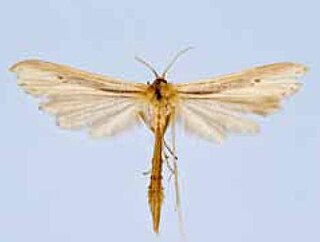
Baccharis is a genus of perennials and shrubs in the aster family (Asteraceae). They are commonly known as baccharises but sometimes referred to as "brooms", because many members have small thin leaves resembling the true brooms. They are not at all related to these however, but belong to an entirely different lineage of eudicots. B. halimifolia is commonly known as "groundsel bush", however true groundsels are found in the genus Senecio.

Platyptilia carduidactyla, the artichoke plume moth, is a moth of the family Pterophoridae described by Riley in 1869. It is found in North America, from Mexico north into the United States.

Stenoptilia zophodactylus is a species of moth of the family Pterophoridae. It is found in Europe, North America, South America, Australia, South Africa, India and Iran.

Lantanophaga pusillidactyla, the lantana plume moth, is a moth of the family Pterophoridae. It is native to the southern United States, Mexico, the Caribbean and South America. It was introduced to Australia accidentally in 1936 and is now found from Sydney to Cairns along the coast. It has also been introduced to Hawaii in 1902, Pohnpei in 1948 and Palau in 1960 for biological control. It has since been recorded from Yap in 1987–1988 and is now distributed on all islands of the Mariana and Caroline Islands where the host plant is found, except Aguijan.

Anstenoptilia marmarodactyla is a moth of the family Pterophoridae. It is native to California and Arizona, south through Mexico to Costa Rica. It is an introduced species in Hawaii.

Platyptilia farfarellus is a moth of the family Pterophoridae. The species was described by Philipp Christoph Zeller in 1867. It is found from central and southern Europe to Asia Minor, Micronesia and Japan. It is also known from Africa, where it has been recorded from Equatorial Guinea, Kenya, Madagascar, Mauritius, Nigeria, South Africa, São Tomé & Principe, Tanzania, Uganda, the Seychelles and Malawi.
Stenoptilodes brevipennis is a moth of the family Pterophoridae. It is known from Argentina, Belize, Brazil, Costa Rica, Cuba, Ecuador, Mexico, Paraguay, Peru, Puerto Rico, Suriname, Trinidad and Uruguay, as well as most of the United States and southern Canada.
Lioptilodes ockendeni is a species of moth in the genus Lioptilodes known from Bolivia and Peru. Moths of this species take flight in March, June and August and have a wingspan of approximately 34–37 millimetres.
Lioptilodes brasilicus is a species of moth in the genus Lioptilodes known from Argentina and Brazil. Moths of this species take flight in October and have a wingspan of approximately 21–22 millimetres.
Lioptilodes doeri is a species of moth in the genus Lioptilodes known from Argentina, Brazil, and Peru. Moths of this species take flight in August and October and have a wingspan of approximately 22–23 millimetres.
Lioptilodes parafuscicostatus is a species of moth in the genus Lioptilodes known from Ecuador and possibly Peru. Moths of this species have a wingspan of approximately 23.5 millimetres. The species closely resembles its sister taxon, Lioptilodes fuscicostata.
Lioptilodes fetisi is a species of moth in the genus Lioptilodes known from Chile. Moths of this species take flight in December and have a wingspan of approximately 21 millimetres. Lioptilodes fetisi is noted for its cream-white colour.
Lioptilodes neuquenicus is a species of moth in the genus Lioptilodes known from Argentina, Chile, and Peru. Moths of this species take flight in October, November and January and have a wingspan of approximately 14–16 millimetres.
Lioptilodes topali is a species of moth in the genus Lioptilodes known from Argentina. Moths of this species take flight in March, May and November and have a wingspan of approximately 29–32 millimetres.
Lioptilodes subantarcticus is a moth of the family Pterophoridae. It is known from Argentina and Brazil.

Hellinsia balanotes, the baccharis borer, is a moth of the family Pterophoridae which is native to Guatemala, northern Mexico, and the United States including Arizona, Texas, Florida, Mississippi, South Carolina and Maryland, but has been introduced to Australia for the control of Baccharis halimifolia. The species was first described by Edward Meyrick in 1908.
Oidaematophorus rogenhoferi is a moth of the family Pterophoridae that is found in Spain, France, Italy, Switzerland, Austria, Germany and Fennoscandia. It is also known from North America and the South Siberian Mountains.

Oidaematophorus eupatorii, the eupatorium plume moth or Joe Pye plume moth, is a moth of the family Pterophoridae. It is found in North America, including Florida, Mississippi, Iowa, New York, California and Vancouver Island. It is also known from Mexico, Guatemala and Panama.

Hellinsia grandis, the coyote brush borer plume moth, is a moth of the family Pterophoridae that is found in North America, Mexico and Guatemala.








